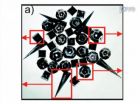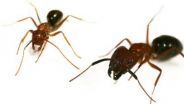(Press-News.org) February 13, 2013
Cambridge, MA: The nanotechnology research space is rapidly growing, with vast implications for the healthcare, consumer electronics, surveillance, and defense industries. However, a major limitation to this research is the ability to create particles that vary in shape and function on a micrometer or nanometer scale.
To overcome these limitations, chemical engineers at Johns Hopkins University have developed self-assembling particles that are inspired by origami, the traditional Japanese art of folding paper into complex three-dimensional shapes. A new article in JoVE (Journal of Visualized Experiments) demonstrates the fabrication and folding of these particles.
"In this video-article, we take the idea of folding up particles and demonstrate the technology in two applications. In the first application, the particles seal up because of glue like material at the edges. In the second part, we talk about structures that reconfigure in response to a stimulus," said author Dr. David Gracias of Johns Hopkins University in Baltimore, Maryland.
VIDEO:
This is the JoVE video published in this article.
Click here for more information.
Dr. Gracias uses a process called photolithography to etch structural designs and flexible hinges on to a 2-D surface. When these complex patterns are exposed to the correct environmental pressures, they can be manipulated to fold and seal or open and close. This fabrication process also allows crucial structural patterns to be printed on 3-D particles, as Dr. Gracias explains: "Patterns are required for electronic circuits, and we allow patterns to be used in 3-D. The applications are numerous, ranging from drug delivery to mechanical sensing, bio-sensing technologies applicable to threat detection, surveillance, and in non-invasive surgery or biopsies."
The authors believe that the applications of this technology are far reaching, and that video publication in JoVE will expedite its adoption by other scientists. "We have developed a new platform, like welding, and we hope that publishing the video will make it more likely for others to use this platform," Dr. Gracias explains. He continues, "One of the concerns with chemistry is that most chemists work with models which cannot be seen. Animation and videos published in JoVE will make these models much easier to understand."
This video article is published in JoVE Chemistry, the newest section of JoVE that was launched in February 2013. "This article really underscores why we chose to open JoVE Chemistry," said Associate Editor Rachelle Baker about Dr. Gracias' article. She continues, "Not only is chemistry a fundamental science but it is a meeting point for interdisciplinary research with bioengineering and physics as well. A video protocol that can enable 2D patterning onto 3D particles of various sizes will be widely applicable to other studies in various disciplines."
INFORMATION:
Gracias et. al.
About JoVE, The Journal of Visualized Experiments:
JoVE, the Journal of Visualized Experiments, is the first and only PubMed/MEDLINE-indexed, peer-reviewed journal devoted to publishing scientific research in a video format. Using an international network of videographers, JoVE films and edits videos of researchers performing new experimental techniques at top universities, allowing students and scientists to learn them much more quickly. As of February 2013, JoVE has published video-protocols from an international community of nearly 6,000 authors in the fields of biology, medicine, chemistry, and physics.
URL: www.jove.com
To link to this release, please use this link: http://www.jove.com/about/press-releases/54/origami-meets-chemistry-in-scholarly-video-article
Contact:
Neal Moawed
Academic Liaison & Marketing Associate
The Journal of Visualized Experiments
p. 617-945-9051
e. neal.moawed@jove.com
Press Access
We offer complimentary access to verified press contacts. If you are interested in being on our press list, please create an account and send an email request to press@jove.com.
Please make sure to follow our Twitter account.
If you have any questions or requests, contact us at press@jove.com.
Origami meets chemistry in scholarly video-article
2013-02-13
ELSE PRESS RELEASES FROM THIS DATE:
A cooler way to protect silicon surfaces
2013-02-13
CAMBRIDGE, MA -- Silicon, the material of high-tech devices from computer chips to solar cells, requires a surface coating before use in these applications. The coating "passivates" the material, tying up loose atomic bonds to prevent oxidation that would ruin its electrical properties. But this passivation process consumes a lot of heat and energy, making it costly and limiting the kinds of materials that can be added to the devices.
Now a team of MIT researchers has found a way to passivate silicon at room temperature, which could be a significant boon to solar-cell ...
Protein central to cancer stem cell formation provides new potential target
2013-02-13
HOUSTON - Researchers have identified a pivotal protein in a cellular transformation that makes a cancer cell more resistant to treatment and more capable of growing and spreading, making it an inviting new target for drug development.
Additionally, the international team led by scientists at The University of Texas MD Anderson Cancer Center found the cancer drug sunitinib potentially has a new role in treating triple-negative, claudin-low breast cancer, a particularly resistant version of a type of cancer that is already difficult to treat.
"We found that FOXC2 lies ...
NASA's Chandra suggests rare explosion created our galaxy's youngest black hole
2013-02-13
New data from NASA's Chandra X-ray Observatory suggest a highly distorted supernova remnant may contain the most recent black hole formed in the Milky Way galaxy. The remnant appears to be the product of a rare explosion in which matter is ejected at high speeds along the poles of a rotating star.
The remnant, called W49B, is about a thousand years old as seen from Earth and located about 26,000 light-years away.
"W49B is the first of its kind to be discovered in the galaxy," said Laura Lopez, who led the study at the Massachusetts Institute of Technology. "It appears ...
By guessing, clinicians may miss 3/4 of alcohol problems
2013-02-13
SAN ANTONIO, Texas (Feb. 13, 2013) — By relying on hunches rather than posing a few screening questions, primary care clinicians may be missing three-fourths of the alcohol problems in their patients, a newly released analysis shows.
"It's often off the radar — people come in for hypertension and are not asked how much they drink," said study co-author Barbara J. Turner, M.D., M.S.Ed., M.A., M.A.C.P., of UT Medicine San Antonio. Primary care offices typically don't have good systems to administer questionnaires to screen for certain problems, including alcohol consumption, ...
Tube versus IV feeding in malnourished pediatric cancer patients
2013-02-13
About 60 percent of pediatric cancer patients experience malnourishment during treatment. At that point, patients and families have a choice: tube feeding or IV nutrition supplement. Which would you choose? A study published this week in the Journal of Pediatric Oncology Nursing shows that families' perceptions, especially of the discomfort of tube feeding, leads to choosing IV over tube – despite the fact that tube feeding is usually the better choice, associated with better gut function and lower rates of infection.
"Despite the benefits of tube feeding, we found a ...
Key molecule suppresses growth of cancerous liver tumors, Mayo study finds
2013-02-13
ROCHESTER, Minn. -- A molecule already implicated in a number of diverse cellular functions can suppress the growth of tumors in the liver, a Mayo Clinic Cancer Center study has found. Its name is IQGAP1, and when the molecule is active in the cells that surround a tumor cell, this "tumor microenvironment" becomes less hospitable to cancer growth. When the molecule is deficient, cancer thrives.
Results of the study appear in the Journal of Clinical Investigation. The findings give new insight into cancer metastasis, the ability of a tumor to spread from its primary site ...
Engineers show feasibility of superfast materials
2013-02-13
SALT LAKE CITY, Feb. 13, 2013 – University of Utah engineers demonstrated it is feasible to build the first organic materials that conduct electricity on their edges, but act as an insulator inside. These materials, called organic topological insulators, could shuttle information at the speed of light in quantum computers and other high-speed electronic devices.
The study published this week in the journal Nature Communications will help pioneer a new field of research in materials science, in the same way organic materials lowered the cost and eased production of light-emitting ...
Epigenetics shapes fate of brain vs. brawn castes in carpenter ants
2013-02-13
PHILADELPHIA — The recently published genome sequences of seven well-studied ant species are opening up new vistas for biology and medicine. A detailed look at molecular mechanisms that underlie the complex behavioral differences in two worker castes in the Florida carpenter ant, Camponotus floridanus, has revealed a link to epigenetics. This is the study of how the expression or suppression of particular genes by chemical modifications affects an organism's physical characteristics, development, and behavior. Epigenetic processes not only play a significant role in many ...
Discovering cell surface proteins' behavior
2013-02-13
Contact:
Bingyun Sun, 778.782.9097, bingyun_sun@sfu.ca
Carol Thorbes, PAMR, 778.782.3035, cthorbes@sfu.ca
Simon Fraser University is Canada's top-ranked comprehensive university and one of the top 50 universities in the world under 50 years old. With campuses in Vancouver, Burnaby and Surrey, B.C., SFU engages actively with the community in its research and teaching, delivers almost 150 programs to more than 30,000 students, and has more than 120,000 alumni in 130 countries.
Simon Fraser University: Engaging Students. Engaging Research. Engaging Communities.
...
Southwest regional warming likely cause of pinyon pine cone decline, says CU study
2013-02-13
Creeping climate change in the Southwest appears to be having a negative effect on pinyon pine reproduction, a finding with implications for wildlife species sharing the same woodland ecosystems, says a University of Colorado Boulder-led study.
The new study showed that pinyon pine seed cone production declined by an average of about 40 percent at nine study sites in New Mexico and northwestern Oklahoma over the past four decades, said CU-Boulder doctoral student Miranda Redmond, who led the study. The biggest declines in pinyon pine seed cone reproduction were at the ...





